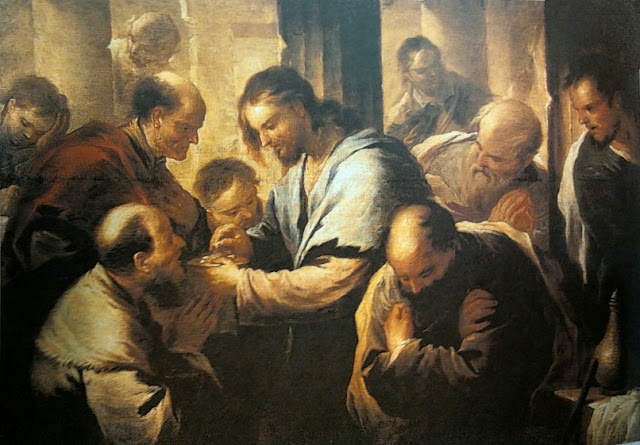Today we celebrate the Feast of the Lord’s Transfiguration – another big word. We probably know “transfiguration” refers to the event in Jesus’s life that we just heard about in the Gospel, but it’s worth looking at the word itself and understanding what it means. A transfiguration is a change in outward characteristics only; the underlying thing remains what it has always been while the figure and appearance change. Standing on the mountaintop, the apostles Peter, James, and John beheld the same Jesus they had always known, but in a radically different way, with his face shining like the sun and his clothes white as light.
 |
| Luca Giordano, The Transfiguration (1685) |
Both of these changes – transfiguration and transubstantiation – tell us something important. In the Transfiguration, Jesus showed the disciples his own true identity as God’s Son and gave them preview of the glory he would have in the Resurrection so that they would not be afraid when he began his journey toward the Cross. By the transubstantiation of the elements at Mass, Jesus shows us disciples here at Mass his nearness to us, the closeness of his abiding Presence that reaches down from heaven to be with us continually in the Eucharist. Like Peter, James, and John, we are witnesses to this change – a change not in appearance that we can see, but a change in substance that we believe by faith.
And in faith, the Real Presence of Jesus under the appearance of bread and wine is our food for the journey of life. Like Jesus, we too must journey toward Calvary. We must take up our Cross, as he did, but thanks be to God that he comes to be with us, to nourish us with presence. By receiving him in the Eucharist – he who was begotten of the Father before all time, who was born of Mary into our world, who was transfigured on the mountain, who died and rose again and sits at the Father’s right hand – by receiving him, we pray that we might one day be brought to share in the glory of the Resurrection ourselves.
 |
| Luca Giordano, Communion of the Apostles (c. 1659) |
I have been following this week some of the coverage of the events of World Youth Day. Around one million young people have gathered from around the world in Portugal to deepen their Catholic faith and to pray with our Holy Father Pope Francis. On Friday, the pope prayed with the youth before they began a Way of the Cross, and he told them that the Cross is “the sacred sign of the greatest love, the love with which Jesus wants to embrace our lives. The Cross shows us the true beauty of love.”
Friends, I think we see the truth of those words in both transfiguration and transubstantiation – in the event that happened on the mountain two thousand years ago, and in the event that will happen here on the altar, at this and every Mass. The apostles beheld the Lord Jesus in glory; we behold him under sacramental signs. But for both of us, it’s the same Jesus who comes to encourage and strengthen us. Let us ask him in this Eucharist to not be afraid by our sufferings, but to be sustained by our faith – faith in the glory that we pray awaits us in the Resurrection and faith in his very Presence here on the altar. And let us say with grateful and believing hearts, “Lord, it is good that we are here.”
1 comment:
Thank you, Father Andrew, for sharing your homily with us.🙏
Post a Comment